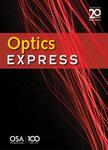版权所有:内蒙古大学图书馆 技术提供:维普资讯• 智图
内蒙古自治区呼和浩特市赛罕区大学西街235号 邮编: 010021

作者机构:Hebrew Univ Jerusalem Dept Appl Phys Benin Sch Engn & Comp Sci IL-91904 Jerusalem Israel
出 版 物:《OPTICS EXPRESS》 (Opt. Express)
年 卷 期:2012年第20卷第16期
页 面:18515-18524页
核心收录:
学科分类:070207[理学-光学] 07[理学] 08[工学] 0803[工学-光学工程] 0702[理学-物理学]
基 金:Israeli Science Foundation (ISF) CAMBR fellowship Brojde fellowship
主 题:Computation methods Electromagnetic radiation Phase velocity Refractive index Rigorous coupled wave analysis Spatial frequency
摘 要:Radiation of electromagnetic waves by a uniformly moving charge is the subject of extensive research over the last several decades. Fascinating effects such as Vavilov-Cherenkov radiation, transition radiation and the Smith-Purcell effect were discovered and studied in depth. In this paper we study the radiation of a line charge moving with relativistic constant velocity within an average zero index metamaterial consisting of periodically alternating layers with negative and positive refractive index. We observe a strong radiation enhancement, (similar to)3 orders of magnitude, for specific combinations of velocities and radiation frequencies. This surprising finding is attributed to a gigantic increase in the density of states at the positive/negative index boundary. Furthermore, we shed light on radiation effects of such a line charge propagating within the more traditional structure of periodically alternating layers consisting of positive and different refractive index with focus on frequencies satisfying the quarter wave stack and the half wave stack conditions. We show that the quarter-wave-stack case results in emission propagating vertically to the line charge trajectory, while the half-wave-stack results in negligible radiation. All these findings were obtained using a computationally efficient and conceptually intuitive computation method, based on eigenmode expansion of specific frequency components. For validation purposes this method was compared with the finite-difference-time-domain method. (C) 2012 Optical Society of America